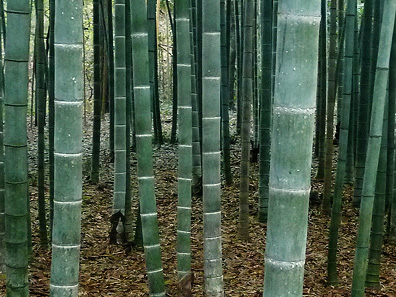Zen and the Art of Gardening

Bamboo FAQ
How do you identify bamboo?
Which bamboo do I need?
It all depends on what you want to do with the bamboo and where you live. Some bamboos are best for screens while others are ideal for specimen or display plants. Although most are very cold hardy you will need an extra cold hardy species if you live in a cold climate. When requesting information let me know your location and what your plans are for the bamboo. The best way to contact me is thru email.
How many plants do I need to start a grove of bamboo?
You can start a grove of giant bamboo with a single plant. For a screen along your property I recommend planting approximately every 5 feet. Most species will fill in nicely in about 3 years planted this distance. You can plant as close as you want if you are in a hurry or spread them out further to save money.
Can I grow both running and clumping bamboos.
Most clumpers are tropical or sub-tropical while most runners are cold hardy. The few cold hardy clumpers are mountain bamboos and can’t handle the southern heat but thrive in northern climates. So it depends on where you live.
How do I control running bamboos?
Bamboo rhizomes will not cross water, such as a pond or continuously flowing stream. You can also place underground barriers in it’s path to control it’s spread or grow it in containers. None of my bamboos have crossed a 10 foot paved driveway. We also have hard packed dirt roads throughout our property seperating different groves of bamboo. If the dirt road is well traveled the bamboo will not cross it. Here is more detailed information on controlling bamboo.
How far apart should I space plants?
In general about every 5 feet. However, you can plant closer or further depending on your budget and how fast you want a screen. If you simply want a grove to admire and walk through you can start with one plant, or perhaps 3, planted in a single area. With regular watering and fertilizing the grove will about double in size each year. More plants will make your grove bigger to start with.
Help, my bamboo is out of control and taking over, what can I do?
Running bamboos can be agressive and very invasive in some cases. To control your running bamboo you need to know a little about it’s habits. How to control running bamboo.
Can I grow bamboo in a very cold climate?
Many bamboos are cold hardy down to about zero and several are hardy to well below zero. You can find pictures and descriptions of the more cold hardy species here. This means they will stay green and leafy down to those temperatures. Once the grove is well established it can survive even colder temperatures. It may suffer top kill but the roots can survive and send up new canes in the spring. Planting in a protected area and mulching heavily will help.
Is Lucky bamboo really bamboo?
No! This popular plant is not a true bamboo, it’s not even related! It is a type of tropical house plant called Dracena. It does look a little like bamboo, but it’s not. If you do a search for “Lucky Bamboo” you can find lots of information on the web.
Can I grow bamboo from seed?
Yes, if you can find bamboo seed! Bamboo only flowers and makes seed on rare occassions. In some cases it may be 100 years or more between flowerings. Because of this it is not common to find bamboo seed available. Although seeds are more common in countries such as China, Japan, India, etc. these are not usually available in the United States because all live bamboo plants and seeds must go through a two year quarantine when imported here. We were able to obtain Moso Bamboo seed a couple of years ago and currently offer unique clones from that seed. With my groves of P.angusta and P.viridis flowering I hope to be lucky enough to collect seed from these species. Time will tell!
Is bamboo the fastest growing plant in the world?
I suppose there may be faster growing plants but it’s hard to imagine once you see new shoots come up in the spring. These can grow 24 to 36 inches or more in a 24 hour period. When bamboo shoots emerge from the ground in the spring they reach full size in just a couple of months time. This includes the giants. It is extraordinary to see a 4 to 5 inch diameter shoot burst from the ground and reach full height (60 feet or more) in just a few weeks. You can easily see the change in height each day. However, once a new culm (cane) reaches full size and leafs out it never grows any higher although it may live up to ten years or more. This means you can prune bamboo at the end of spring and not have to worry about pruning again until new shoots emerge the following year. The above facts often cause some confusion. If you plant a 2 gallon specimen of one of the giant bamboos, it will not send up full size canes the first spring. The bamboo has to form a grove and build up reserves over a few seasons, sending up larger and larger canes each spring. When the grove has reached a large enough size it will send up full size (giant) canes each spring.

Copyright © BigPlants.com
James Mortensen